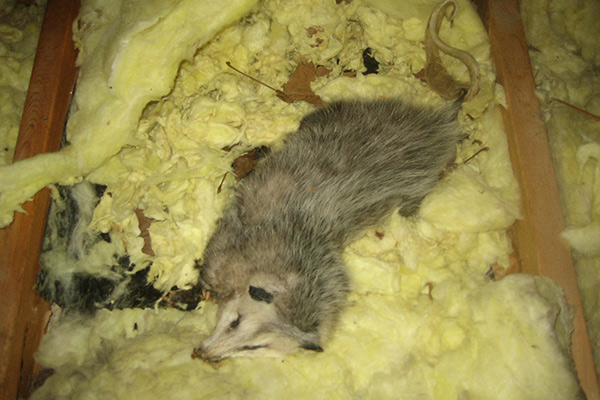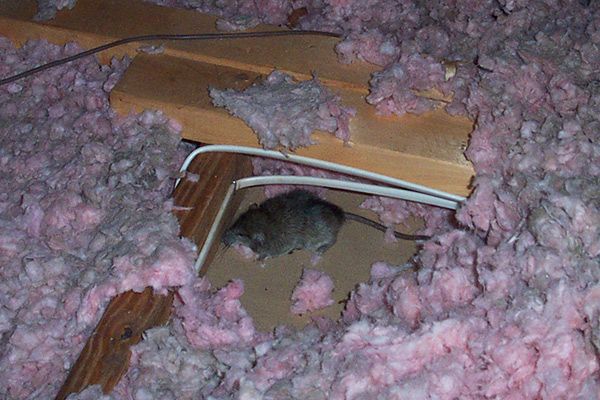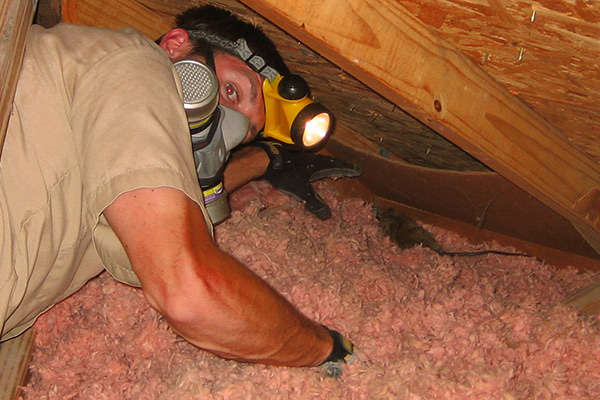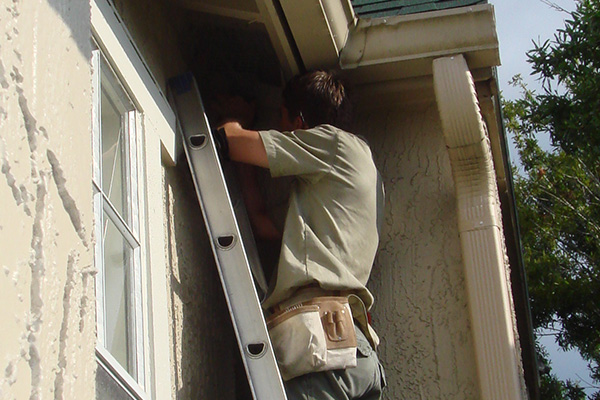- info@animalatticpest.com
- Call - we service 300 locations

How To Get Dead Animals Out of Your Attic
The smell of a dead animal decomposing inside your house is the WORST. The stinky stench is beyond compare. You may be visiting this site because you noticed a bad smell coming from the attic, or from the ceiling or walls, or just a
terrible odor inside the house, and you suspect a dead critter somewhere. Maybe you have some clues, such as prior knowledge that you had an animal or two crawling around up there, and you didn't address the issue. Or, more commonly,
you had a rat or mouse problem, and you put some poison in the attic, and now you've got some dead rodents up there. So how do you find a dead animal in your house?
You follow your nose! There is no magic machine or device that finds dead animals. Try to narrow down the source of the odor - and no, it's rarely from the air ducts - you just think that because the moving air gets the scent around. If you
can narrow down the source to one room in your house, that's a good start. Go up into the attic above that room. Go back and forth, and try to narrow down the strongest stench. You may have to dig under the insulation. If the animal isn't
up there, or if there is no attic to crawl around in, then the animal is in a wall, or a ceiling gap, or something like that. Sniff the walls and the ceiling, back and forth, until you come upon the ripest odor. Once you've got the spot,
cut it open with a drywall saw.
Once you have the location of the dead varmint, either in the attic or in a wall, bag it using disposable latex gloves. Wipe up juices and maggots, and bag soiled insulation if there is any. Clean the area with a good bleach-based cleaner
or an enzyme cleaner like Bac-Azap, which I use. After the animal is out of the house, open the windows to air the place out! The odor relief should be very quick. Dead animal carcass removal is difficult for amateurs, so if you can't find
it, call out an experienced expert: click here for your local wildlife pro. If you don't remove the dead animal, you'll have to wait a couple weeks (for a mouse) or a couple months (for a raccoon)
for the maggots to eat the animal and for it to dry up and mummify. Only then will the odor go away.
How to Get Rid of Dead Animals in the Attic - 4 How-To Steps
1 - Inspect the Attic, Find Dead Animal
Inspect inside your attic for dead animal sign. Look for their feces, or tracks, or better yet, follow the stench, to pinpoint the location.
2 - Sometimes You've Got to Dig a Little
Many animals that die in the attic crawl underneath the insulation. You may have to dig around to find the carcass. Of course, a stain on the ceiling is a clue.
3 - Bag the Animal and Deodorize
Once you find the dean animal, (wearing gloves and respirator) bag it in garbage bag, along with soiled insulation and maggots, and spray the area with a cleaner.
Information About Dead Animals in the Attic
How To Get Dead Animals Out Of Your Attic
If you think having a live animal in your attic is a problem, you may not realize that a dead one can be even worse. While you can trap the live animal or use exclusion to get it out, you won’t get any assistance from the wildlife in question if it is dead. Instead, you will have to search the entire area to find the animal before its carcass begins to rot and smell – which happens very quickly. Although it is a challenge to get dead animals out of your attic, it can be done if you know what you are doing.
Hire A Professional
The easiest way to get dead animals out of your attic is to have a professional do the job for you. They will have experience finding the animal carcass, something which saves time and can minimize the amount of demolition you have to do to find it. Because of their experience, they are also less likely to be grossed out by the carcass or any maggots or flies that are near it. Simply put, the process will go more quickly and smoothly with a professional and you won’t have to worry about anything that grosses you out.
Follow Your Nose
If you want to try to get rid of the dead animal by yourself, then you will want to do just what the professionals do. Start by walking around your home and using your nose as your guide. If you know the dead animal is in the attic, then you will want to walk around the top floor of your house. Pay close attention to where the smell gets stronger or where it gets weaker. Don’t forget to factor in ventilation. If, for example, the smell is stronger right by a vent, the animal may be by that area of the attic or by the vent’s source within the attic.
Inspect The Attic Thoroughly
Once you have narrowed down the general area where the dead animal odor is strongest, you can go up to the attic and start looking for the animal in question. Start in the area where the scent was the most overpowering, but don’t be afraid to check the surrounding areas as well. You may need to inspect the entire attic carefully to find it.
During your attic inspection, don’t forget to look under items. Many animals, for example, like to nest in insulation or under furniture stored in the attic. If you don’t see any signs of the animal by the area where the smell is strongest, look in the insulation or move some items around. There is a good chance the animal chose to die in a place it felt safe and comfortable, which unfortunately for you translates to hidden and hard to reach. In some cases, you may even need to cut a hole in your drywall to find the animal carcass. This is one of the reasons hiring a professional makes sense; they can minimize cuts in the drywall based on their experience and expert sniffers.
Remove The Dead Animal
Once you find the dead animal, it is time to get it out of your attic. Make sure you have a sturdy garbage bag handy and wear a thick pair of gloves and a mask. Pick up the animal (preferably using a bag or towel in addition to your gloves) and place it in the garbage bag. You will want to double bag the body to reduce the odor and its attraction to other animals. This is also the time to remove any live maggots or other waste products surrounding the animal.
Depending on the animal in question, the issue of what to do with it can be a challenge. You will always need to check local regulations before doing anything. In most cases, you will be able to throw out a squirrel or something smaller with your normal trash collection, provided it is at least double bagged. In other cases, you may have to bury or burn the body. Your area may also have a specific location for you to bring the dead animal to for proper sanitary disposal.
Read about How To Find a Dead Squirrel in the House.
Clean The Area
Finally, you can clean up your attic and get rid of any signs that the animal was there. Use a strong disinfectant or an enzymatic cleaner to thoroughly sanitize the entire attic, focusing on the area where you found the carcass. This will help minimize the odor and prevent bugs and other pests from being attracted to the area. It also reduces your risk of disease. When cleaning the attic, remember to wear proper protective gear and wash your hands and arms thoroughly after.
Don’t forget to seal up any entrances to your attic that the animal may have originally entered through. If there are windows in your attic, consider opening them (but watch out for wildlife) to help ventilate the area and reduce the odor more quickly. For those who don’t want to deal with the cleanup process themselves, you can also hire someone to do it for you.
The Bottom Line
How to get rid of dead animals in the attic - you've basically got to sniff around! Be persistent. Sometimes the animal is in the furthest, darkest corner, or below the insulation, or in a duct, or down a wall. In fact, that's most of the time. They rarely lay out in the obvious open. But if you look for the flies flying around, or the rotten juices on the ceiling, or most of all, go back and forth, back and forth, following the scent, you'll find it. You may have to cut open a hole to get it, and you may have to bag maggots and juicy insulation, but if you don't remove the dead animal, the horrible stench will continue for weeks or even months, depending on the size of the animal. You can get rid of dead animals in the attic if you follow the correct approach. Best of luck!




